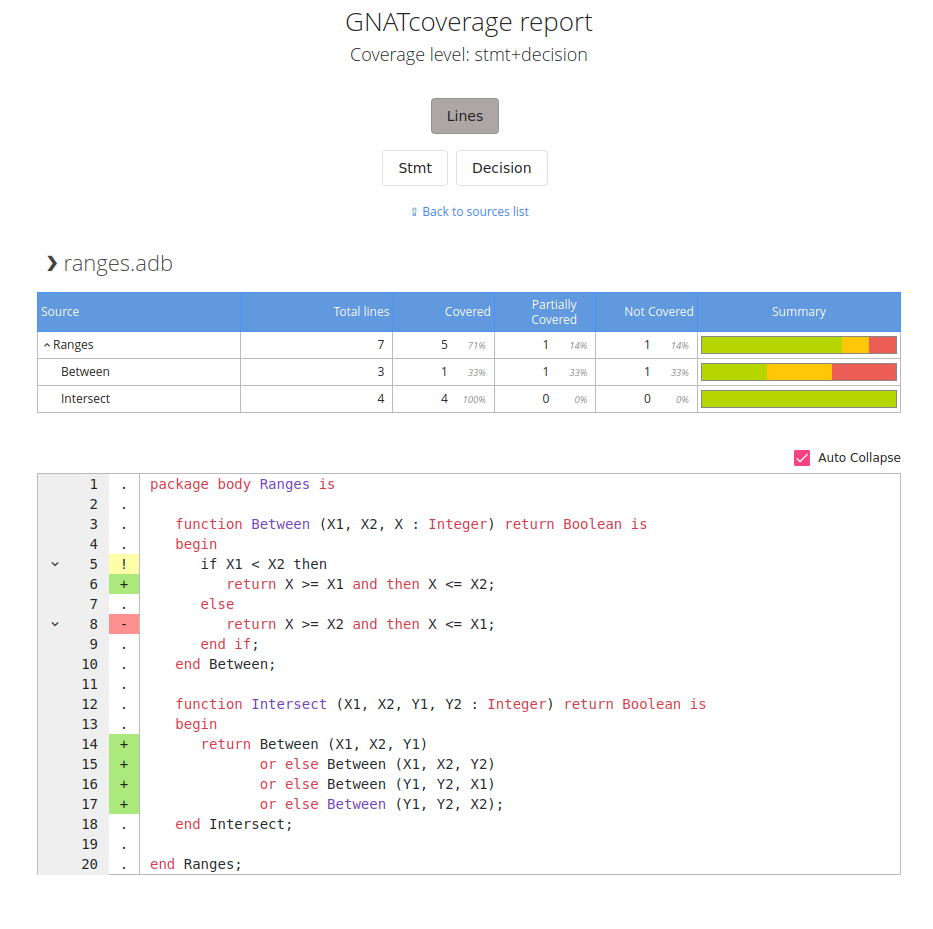Appendices¶
Sample html index¶

Sample html annotated source¶

Target specific points of note with Binary traces¶
The following list summarizes points of note for each target where some aspects of the build/execution/analysis process depart from the general instructions.
For cross configurations in general:
Need to convey the target to gnatcov run, either with a
--targetswitch or aTargetproject file attribute;Need to convey the target and Ada runtime when using project files to state units of interest, for gnatcov coverage, gnatcov instrument or gnatcov run. See Specifying Units Of Interest, Other switches or attributes of importance.
For powerpc-vxworks6:
Need to compile with -gno-strict-dwarf -mlongcall for source coverage analysis;
Need to add a –kernel argument on gnatcov run;
The provided kernel has to be augmented with a specific module for gnatcov purposes. Please refer to the GNATemulator documentation for this part of the process;
Support for the
kernelAda RTS and Downloadable Kernel Modules only.
For Windows native:
One can omit the extension for the program passed to gnatcov run. So for instance on this target,
gnatcov run foois equivalent tognatcov run foo.exe. In any case, unless the-ooption is passed, the name for the generated trace file is based on the actual program file name, not the one passed to gnatcov run. So both previous examples will generatefoo.exe.tracefiles. Besides, both will leave “foo.exe” as the executable name stored in the trace header.
Known Limitations with Binary traces¶
Incomplete statement coverage on lines with multiple statements¶
On lines with multiple statements, the tool may not be able to infer accurate statement coverage results for each individual statement. The tool emits explicit diagnostics in this case.
In =report outputs (with --annotate=report), this
translates as a statement coverage violation like:
<sloc>: multiple statements on line, unable to establish full statement coverage
where <sloc> is a source-filename:line:column source location of the problematic line.
In annotated sources kinds of outputs, this materializes as ‘!’ note
indicating partial coverage on the affected lines, with the =report
violation text quoted above available as part of the line extra-details
expanded on demand (=html+ and xcov+ output formats).
MCDC inaccuracies with interrupts and multi-threaded applications¶
There is one limitation in GNATcoverage with respect to MCDC assessments from binary traces: potential inaccuracies in results reported for particular decisions when these decisions are evaluated concurrently by different threads or mixed with interrupt processing in bareboard configurations.
Technically, the decisions of concern are those for which the associated binary decision diagram is not a tree, that is, those with at least one condition node joining several possible evaluation paths.
The code sample below illustrates the simplest possible problematic decision and the following figure depicts the corresponding Binary Decision Diagram (commonly abbreviated as BDD), which states how sequence of operand evaluations, starting from the left, eventually lead to the expression outcome, here on the right:
function Mp (A, B, C : Boolean) return Boolean is
begin
return (A or else B) and then C;
end;

BDD for (A or else B) and then C, not a tree¶
The expression BDD is indeed not a tree, as the node representing the evaluation of C is reachable either directly from A, when A is True, or via B when A is False.
According to measures performed on a few large real code bases, occurrences of such decisions are statistically rare. gnatcov can report about them on demand, thanks to the scan-decisions command together with the the set of coverage obligations to examine. Below is an excerpt of a an execution for a project which encompasses this function, where we see that gnatcov provides the source location of conditions rechable through multiple paths:
gnatcov scan-decisions -Pmytest.gpr
...
*** mp.adb:4:33: warning: condition is reachable through multiple paths